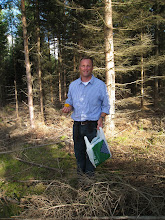
I have been remiss in taking photos and adding text to this blog showing my efforts at home barley growing for malting. In June 2010, I harvested by hand barley from my 1,000 square foot garden plot (photo at left). Unfortunately, I did not take any photos of the harvest.

Here are photos of me and my younger son, Ture, threshing the barley a couple of weeks ago. I made a two level wooden box with a 1/4 inch galvanized hardware cloth screen attached to the bottom of the top box. I basically rub the barley heads through the screen and the barley and chaff fall into the bottom box. A pair of leather gloves help since the barley has brittle parts that can be sharp and cause splinters. This has proven a pretty effective way to get the grain off the heads and the awns (long stalks coming off the tip of each grain of barley) off the grain. The process does not damage the husk of the barley, which is important for all-grain brewing. I can thresh 25 pounds of barley in a fifteen monutes using this cheap and effective method.


Here are photos of me subsequently winnowing the barley. The process involves separating the lighter chaff from the heavier grain. The chaff blows away (notice it on the ground) and the barley grains fall into the tub below the fan. The day was not windy, so I used an electric fan to make breeze. The process works very well (probably removes 98% of the chaff), but does leave some heavier chaff in with the grain. I will have to pick through the grain I will malt to remove as much of the residual chaff since I will want my malt to be free of this non-barley stuff. Note that all the "equipment"

for processing barley on a

small scale is basically stuff you have sitting around the house. I did have to make the threshing box, but it was from scrap wood, screws, and mesh I already had laying around. I think I could probably process up to

maybe 200 pounds rather easily using these techniques.
I tilled the plot three times, each about a week apart to try to give weed seeds a chance to sprout and then be killed by the subsequent tilling. I put come lime and some 10-10-10 fertilizer on the plot and tilled it in.
Today was supposed to be about 60 degrees and rainy, which is perfect barley sprouting weather (barley sprouts above 50 degrees and likes cool weather to grow), so yesterday I tilled the plot (using my 17", 5 hp Sears gas tiller) for the last time and raked it smooth. I broadcast (casting it evenly out of your hand -- think middle ages agricultural techniques here) about 4 pounds of my threshed and winnowed barley seed evenly across the plot. Photo of broadcasting barley seed below.

I then very lightly raked the top of the plot to lightly bury some seed and increase its contact with the soil. This also helps thwart some birds and squirrels, which are tenacious barley-eaters until it puts up shoots.
It rained overnight and the plot looks good. The rain is also helping to keep the pests off the plot, at least temporarily.
If all goes well, I should see green shoots in about a week to ten days. My the time the weather gets really cold here in Herndon, Virginia the barley grass should be about 8 inches high. This grass will sit under the snow and tolerate the cold throughout thew winter. In the spring it will get

going early and start putting up the sprouts that will hold the barley heads in April. Then harvest will be in June after the barley turns golden and a grain cracks between your teeth.
Weeds are a big potential problem (which is why I tilled 3 times to try to get resident weed seeds to sprout so I could kill them with the tiller). The goal is not to eliminate all weeds, which I will never be able to do, but to control then so they don't smother the barley. Once it is established, barley grows robustly and can hold its own against most weeds except ones that put up vines.
Above: Photo of planted barley plot (50'x20'), October 13, 2010.
I will publish a post on home malting shortly.






















































